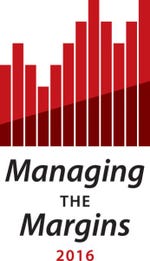February 3, 2016

The problem many U.S. farming operations face now is the ability to cash-flow the business for the next 18 to 24 months. The long-term concern is the overall debt-load of the farm business.
A new year provides farm managers an opportunity to focus on some managerial resolutions to prepare their farming businesses for what is expected to be a period of tight, even negative, profit margins and potential financial stress.
Here is a quick list of managerial resolutions to help get 2016 off to a better start:

(Editor’s note: Ths is the first article of the Southeast Farm Press “Managing the Margins: 2016” editorial series, which is specifically for Southeast farmers to help them make the best, most-informed decisions in order to manage the financial risks of farming in the Southeast.)
(Editor’s note: Ths is the first article of the Southeast Farm Press “Managing the Margins: 2016” editorial series, which is specifically for Southeast farmers to help them make the best, most-informed decisions in order to manage the financial risks of farming in the Southeast.)1 - Use enterprise budgets to determine what price you need from the market to be profitable. Having up-to-date and accurate financial records for each crop enterprise produced is necessary to price the crop at profitable levels. You can use a budget produced by Extension or the land-grant college in your state to determine the per-bushel cost. It is crucial that you adjust these budgets to your production practices, yield potential and costs incurred in producing the crop. Your
2 - Find cost-savings without jeopardizing yields. The five most expensive items in the University of Kentucky’s corn budget are: 1) cash rent, 2) seed, 3) nitrogen, 4) machinery depreciation, and 5) herbicides. In total, these five expenses account for about 80 percent of the total economic cost of growing corn in Western Kentucky. An agronomic specialist might be able to fine-tune the fertilizer, seed and herbicide expenses a little but with marginal cost savings. The big ticket items are land rent and machinery depreciation. Land rents have not decreased proportionally with the lower expected profitability. Cash rents are sticky partially due to farmers having equity to pay premiums for one more year and also because additional acres farmed reduced the per acre machinery depreciation expense.
3 - Market crops above your break-even prices. Just because you sold your crop at the break-even price level from resolution #1 doesn’t mean that you’ve covered all of your expenses. You can still go broke by just breaking even. Think about the costs that aren’t in an enterprise budget. Two prominent expenses not fully captured in an enterprise budget are family living expense and current principal and interest payments on debt.
Family living expense has grown along with cash rental rates and farm profitability. The average family living expense for farms participating in the University of Kentucky’s Farm Business Management record-keeping program had an average family living expense of $51,300 with the top 1/3 spending over $102,100 in 2014 on family living expense. This is from 220 grain farms with an average of 2,200 tillable acres per farm. How much of this family expense can be reduced quickly and painlessly without creating family anxiety for the farm manager?
KFBM data also shows that current liabilities for all grain farms averaged $750,000 in 2010 but has grown to a projected $1.2 million for 2015. This current debt is the amount due within a 12-month period. Long-term debt has grown from $600,000 in 2010 to a projected $1 million for 2015. Part of this debt increase is refinancing of current debt into long-term debt collateralized by land.
Working capital is your War Chest
4 - Protect you working capital at levels to provide cushion against risk. Working capital is the difference between cash plus assets quickly converted to cash like grain inventory less the current liabilities due within a year like principal and interest payments on current and multi-year debt.
Working capital is your financial “war chest.” The amount of working capital affects your ability to withstand risk of lower prices, lower yields and higher costs. Part of this working capital value has eroded solely through the lower value of stored grain. Consider the value of 10,000 bushels of corn plus 10,000 bushels of soybeans valued at $6 and $13 per bushel, respectively, versus $3.90 and $8.90 per bushel, respectively. The former provides working capital of $190,000 while the later provides working capital of $128,000. That is a loss of working capital of $62,000 due to lower commodity prices.
The working capital ratio in 2013 for Kentucky grain farms averaged 2.06, which means there was $2 of assets easily converted to cash for every $1 of liabilities due during the year. This ratio decreased to 1.79 for 2014 and is projected to be 0.51 for 2015. A working capital ratio of 0.51 means that farmers only have $0.51 in assets that are easily converted to cash available to pay every $1 of liabilities due within the year. In short, the financial war chest is almost depleted. This suggests increased borrowing is needed to pay for current debt.
How can working capital be improved? Most of the asset side of the equation is determined by profitability (retained earnings in the form of cash) and inventory values. A record corn and soybean harvest in Kentucky for 2015 is cushioning somewhat the impact of low prices. The best way to improve working capital is to reduce the liabilities side of the balance sheet. Managers should consider the benefits of restructuring debt, if land is available for use in collateral, with fixed interest rates to lower the annual principal and interest rate payments to increase working capital. If capital assets were financed on short-term notes, this could be an opportunity to refinance at terms equal to the asset’s life with fixed interest rates.
(Todd Davis is an Assistant Extension Professor of Crop Economics Marketing and Management with the University of Kentucky. He can be reached at [email protected].)
You May Also Like




